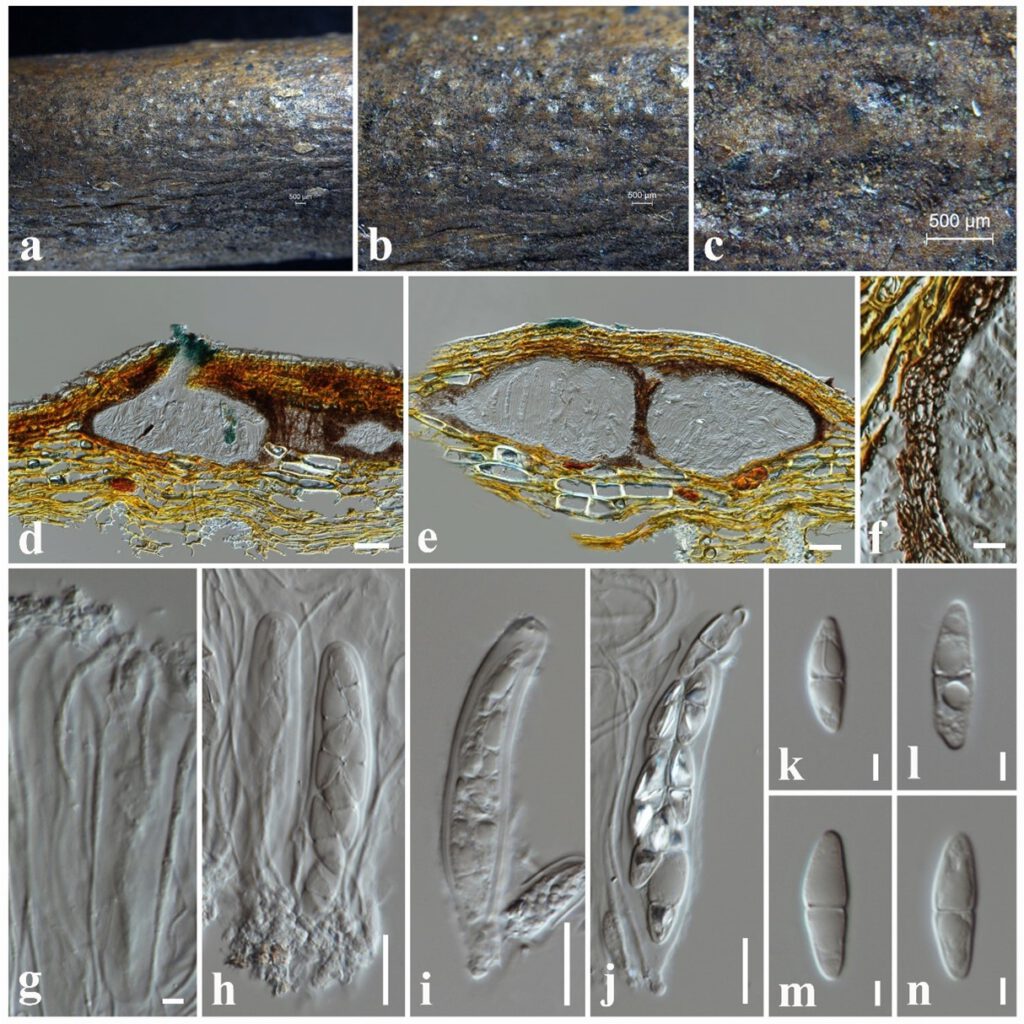Neomassaria thailandica N.I. de Silva, Lumyong & K.D. Hyde, sp. nov.
MycoBank number: MB 559520; Index Fungorum number: IF 559520; Facesoffungi number: FoF 10718, Fig. 6.23
Etymology: The epithet ‘thailandica’ referring to the country (Thailand) where the specimen was collected.
Holotype: MFLU 21-0239
Saprobic on dead twigs attached to Anomianthus dulcis. Sexual morph: Ascomata 170–200 μm high × 200–280 μm diam. ( = 190 × 250 µm, n = 10), solitary or scattered, coriaceous, immersed to slightly erumpent, visible as black dots on the host surface, unilocular or bilocular, globose to subglobose, brown to dark brown. Ostiole central. Peridium 12–20 μm wide, comprising light brown cells of textura angularis, cells towards the inside hyaline, fusing at the outside indistinguishable from the host tissues. Hamathecium comprising 1–2 μm wide, cylindrical to filiform, septate, branched, pseudoparaphyses. Asci 80–120 × 14–22 μm (= 95 × 18 μm, n = 20), 8-spored, bitunicate, oblong to cylindrical, short pedicellate, with ocular chamber. Ascospores 20–28 × 6–9 μm (= 26 × 8 μm, n = 30), overlapping 1–2-seriate, hyaline, ellipsoid to fusiform, 1-septate, constricted at the septum, without a mucilaginous sheath. Asexual morph: Undetermined.
Culture characteristics – Colonies on PDA reaching 20 mm diameter after 2 weeks at 25°C, colonies from above: grey, circular, undulate margin, flat, slightly raised, white at the margin; reverse: greyish brown from the centre of the colony, cream at margin.
Material examined – THAILAND, Chiang Rai Province, dead twigs of Anomianthus dulcis (Annonaceae), 4 April 2019, N. I. de Silva, AND4 (MFLU 21-0239, holotype), ex-type living culture, MFLUCC 21-0193.
Notes – The morphological characteristics of our collection fir well with Neomassaria species in having immersed to erumpent, coriaceous, globose to subglobose ascomata, oblong to cylindrical asci and hyaline, ellipsoid to fusiform, 1-septate ascospores (Hyde et al. 2016, Ariyawansa et al. 2018, Hongsanan et al. 2020). Multi-gene phylogeny indicates that our collection constitutes an independent lineage between Neomassaria alstoniae and N. fabacearum with 99% ML and 1.00 BYPP support. Their morphological differences are mentioned in Table 3. A comparison of the 902 nucleotides across the tef1 gene region of Neomassaria thailandica and N. fabacearum shows 39 base pair differences (4.32%).

Figure 6.23 Neomassaria thailandica (MFLU 21-0239, holotype). a The specimen. b, c Appearance of ascomata on substrate. d, e Vertical sections through ascoma. f Peridium. g Pseudoparaphyses. h–j Asci. k–n Ascospores. Scale bars: a–c = 500 μm, d, e = 50 μm, f = 10 μm, g = 5 μm, h–j = 20 μm, k–n = 5 μm.
